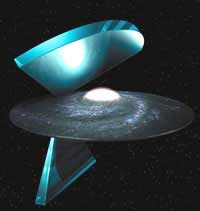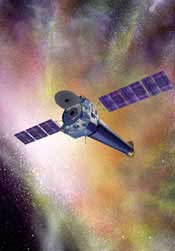
Astronomers use galaxies to reckon a subatomic particle’s mass.
By mapping hundreds of thousands of galaxies, astronomers have estimated the mass of the neutrino. They have also calculated the contribution that this mysterious subatomic particle makes to the total mass of the Universe.
The neutrino weighs no more than one-billionth of the mass of a hydrogen atom, Ofer Lahav of the University of Cambridge told the annual UK National Astronomy Meeting in Bristol today. Yet

Astronomers may have discovered a strange new form of matter.
Astronomers think they might have spotted a quark star, a mass of fundamental particles only a few kilometres across but weighing more than our Sun. If the star’s nature is confirmed, it would be the first example of this state of matter.
Theoreticians hypothesized the existence of quark stars in the 1980s. Today, NASA announced the discovery of such a star, based on results from their space telescope the Chandra

In a laboratory in Nottingham, scientists are now creating the uniquely harsh conditions encountered in interstellar space. In an environment where the pressure is only one ten billion billionth (one part in 10 to the power 13) of atmospheric pressure, and the temperature a mere 10 degrees above absolute zero, Dr Martin McCoustra and his colleagues are able to mimic the surfaces of the ice-coated dust grains in interstellar clouds and to study the complex chemical and physical processes that take pla

Astronomers at the University of Southampton have uncovered a remarkable connection between the monstrous black holes residing at the hearts of distant galaxies and their comparatively tiny cousins which inhabit star systems in our own Milky Way: they are playing the same tunes. Dr Phil Uttley presents these findings in a talk called `The music of black holes` at the National Astronomy Meeting in Bristol on Tuesday 9 April.
Massive black holes, a million to a billion times heavier than the S

One of the most fascinating areas of astronomical research in recent years has been the search for other `Earths` circling Sun-like stars far beyond our Solar System.
In recent years nearly 100 planets have been discovered in orbits around other stars, but none of these `exoplanets` remotely resembles the Earth. However, according to the latest computer simulations by Barrie Jones and Nick Sleep (The Open University), millions of Earthlike worlds could be scattered throughout the Galaxy, ju

The European Space Agency is planning its first mission to unveil the mysteries of Earth`s cloud-shrouded sister planet, Venus. On Wednesday 10 April, Professor Fred Taylor (University of Oxford) will be explaining to the UK National Astronomy Meeting why European scientists are hoping to be on board the Venus Express in 2005.
Venus, the Earth`s nearest planetary neighbour, is remarkably similar in size and mass to our own world. However, its atmosphere and climate could hardly be more diff

New VLT Discovery Pushes Back the Beginnings
Using the ESO Very Large Telescope (VLT), a team of astronomers from The Netherlands, Germany and the USA [1] have discovered the most distant group of galaxies ever seen, about 13.5 billion light-years away. The Photo shows the sky region near the power

A new type of optical material has been developed by physicists that could replace the electronics used to route the light signals through optical fibre telecommunications networks. It could even provide the basis for future `optical computers` working on light pulses instead of electric signals. At the Condensed Matter conference on Monday 8 April, part of the Institute of Physics Congress in Brighton, Dr David Sharp, a member of Dr Andrew Turberfield`s research team from the University of Oxford, w

When it was announced last month that the Mars Odyssey satellite had found water ice beneath the planet`s frozen carbon dioxide south polar ice cap, “I felt excited!” says Dr Lidija Siller, a physicist from the University of Newcastle. “I believe that the data I have explains how this water got trapped underneath the surface”. Dr Siller will be presenting the results of her research – which involves studying photochemical reactions in ice – at the Condensed Matter physics conference on Monday 8 April

Physicists at Glasgow University are using the world`s most powerful laser beam as an atom smasher to simulate conditions inside the Sun and to produce radioisotopes vital in medicine. Professor Ken Ledingham from the Department of Physics at Glasgow and his colleagues from Imperial College and the Rutherford Appleton Laboratory (RAL) are using the world`s most intense laser beam, produced by the VULCAN laser at the RAL near Oxford, to initiate nuclear reactions for a variety of exciting application

Chalmers researchers in Sweden, in an EU project involving colleagues from France, Holland, Germany, Italy and Finland, have shown that outdata from superconductor quantum computers can be read directly, even though the signal consists only of the presence or absence of two electrons, a so-called Cooper pair.
How far away are we from a functional quantum computer? Research results on quantum computers are beginning to appear. Göran Johansson at the Department of Microelectronics and Nanosci

A tiny measurement system that incorporates a lens as thick as two human hairs has been developed by researchers to investigate the force exerted on the wall of an artery as blood whooshes past. In a research paper published today in the Institute of Physics publication Journal of Micromechanics and Microengineering, Dr Rob Keynton and colleagues at the University of Louisville, Kentucky and Michigan Technological University, USA describe how they have designed and made an integrated miniature acous

A computational trick that stops imaginary knots collapsing could help us understand how to unravel a loop of DNA or reveal the true nature of elementary particles, research published today suggests.
In the New Journal of Physics, published jointly by the Institute of Physics and the German Physical Society, Phoebe Hoidn and Andrzej Stasiak of the University of Lausanne, Switzerland, and Robert Kusner of the University of Massachusetts, USA, explore the mathematical complexities of particula

Technological advances take place all the time – driven by need. But can these advances be speeded up in quantum leaps? The European Space Agency thinks they can, and is launching a pioneering project to test this.
The European Space Agency has launched a project to test whether technological advances can be speeded up in quantum leaps. The Star Tiger project will gather together a small team of enthusiastic scientists and engineers with a range of expertise from around Europe, put them toge

Astronomers shoot first film of the stars, dust and gas at the centre of a galaxy.
Astronomers have made their first movie of the roiling mass of stars, dust and gas at the centre of a galaxy.
The movie zooms into the disk of saucer-shaped galaxy NGC 1068 and through its super-bright core. It reveals an energetic region of space created by material flying out of the suspected black hole at the centre and crashing back into the disk. This region appears as a pale blue cloud

The planet Jupiter has spectacular rings of auroras around each pole but until now scientists have not been able to explain how they form. All auroras are caused by energetic charged particles crashing into the top of the atmosphere and making it glow. In the Earth’s auroras, these particles come from the Sun in a flow of charged particles known as the solar wind. But this can’t account for Jupiter’s auroras because the solar wind does not reach to the region where the brightest are found. Space phys